I enjoy learning about automotive “firsts,” because I think there’s something inherently interesting about the first of anything that eventually becomes something much bigger. These events and milestones are interesting because at the time of their creation, it’s usually not especially clear what their eventual impact will be, and, maybe even more excitingly, often these firsts occur far earlier than one would guess. They’re just kind of fascinating and fun, and I think I have an interesting one to share with you today.
Oh, and there’s also my longstanding vendetta against Mercedes-Benz, who still claim the “first automobile” even though their claim is absolute unmitigated horseshit. I think they know this, deep down, as they even have a strange “forerunners to the automobile” page that effectively disproves their own claim, and yet they somehow try to use this as more evidence for their claim. What a pack of jerks, am I right?
But I’m getting off track here; what I want to tell you about today is what seems to be the first reference to an actually existing horseless carriage in Western literature, though I’m not certain we can call this vehicle an “automobile.” It’s a sort of sticky question, one I’ve addressed before, and I’m not really certain I have a better answer today. But it is mentioned in a famous, or maybe infamous, work of literature, all the way back in 1759.

That work of literature is Laurence Sterne’s strange and rambling and funny and surprisingly modern (or post-modern or something like that, I’m sure there are dissertations that go into all of that) nine-volume novel The Life and Opinions of Tristram Shandy, Gentleman.
Among certain well-read people, like my librarian friend, this is an incredibly important work, and I feel bad that even though she’s been trying to get me to read the thing for decades, I’ve never really managed to get very far. But that doesn’t mean I don’t respect it! The book does some wild things with typography and lambasts the overbearing formalities of the era, and is by all accounts a wild, unhinged romp that I suspect one could think of as the start of a line of literature that ends up with Hunter S. Thompson’s Gonzo Journalism. It seems great.
But, at the moment, all I want to focus on is a claim I encountered in David Burgess Wise’s 1977 book, The Motor Car. In the book, Wise makes the claim that the first “horseless vehicle” mentioned in literature is a massive land yacht (not of the Cadillac or Lincoln variety) that was powered by wind and carried about 28 people.
Wise didn’t mention the specific quote, but I think I found it (emphasis mine):
“What shall we say of the great Piereskius?—That’s the very man, cried my uncle Toby, I once told you of, brother Shandy, who walked a matter of five hundred miles, reckoning from Paris to Shevling, and from Shevling back again, merely to see Stevinus’s flying chariot.“
“Stevinus” refers to Simon Stevin, a Flemish mathematician and music theorist who also seemed to dabble in building massive wind-carriages, and one he built around 1600 for Dutch prince Maurice of Orange-Nassau seems to be what was being referenced as the “flying chariot.”
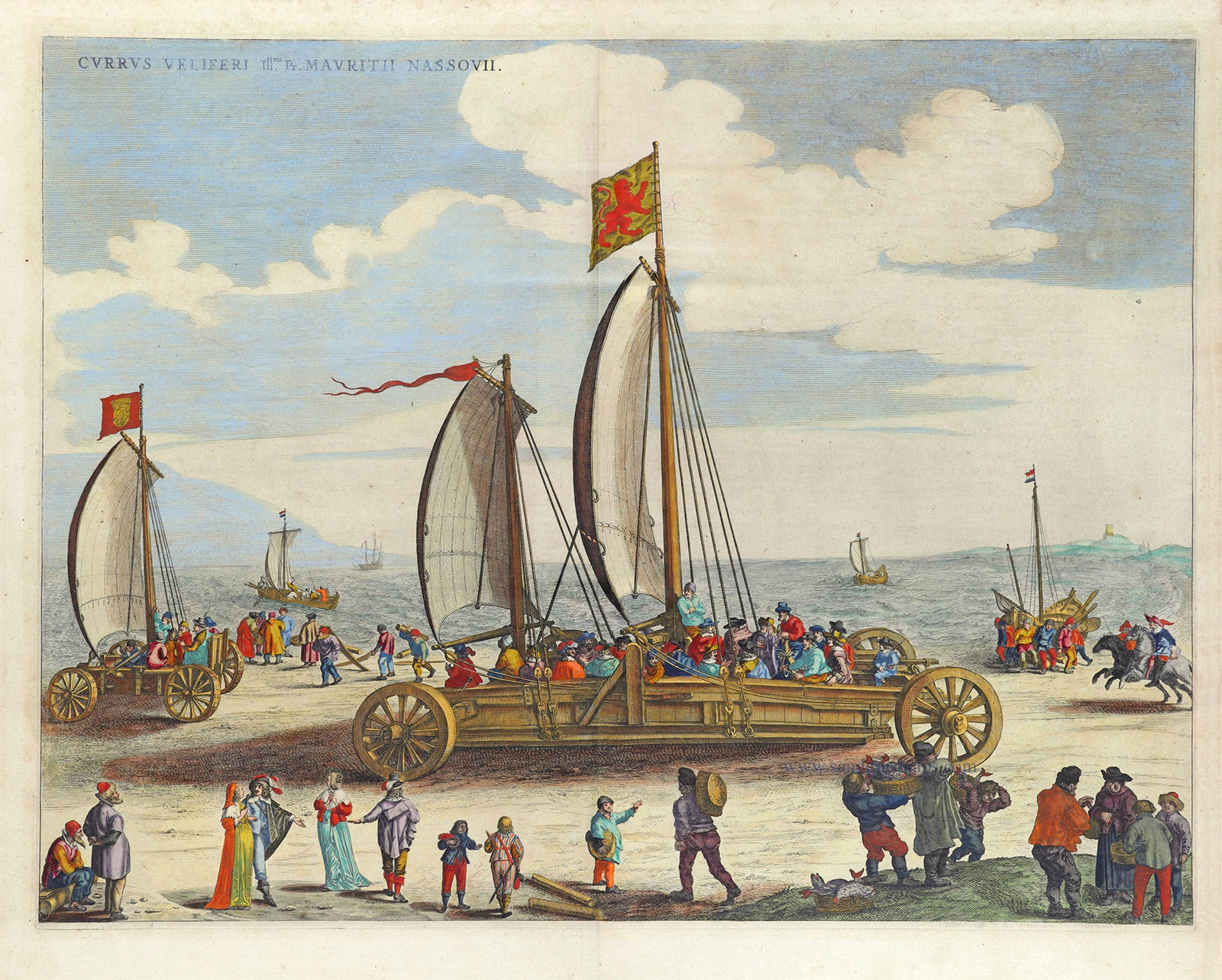
The land yacht or sail carriage or wind carriage or whatever we want to call this thing is certainly an impressive beast; it’s huge, carrying an awful lot of people, and has two very ship-like masts. Based on most period representations (that one up there is from 1649), the construction looks quite naval, like a long, low ship with massive artillery-type wheels.
There looks to be some sort of leaf-spring type of suspension, though I can’t really tell, and what I may be reading as the leaves could be more heavy timber, but the rear axle does seem to be on some manner of pivot for steering, in a rudder-like manner that reflects the nautical inspiration for this machine.
But here’s my question: is this an automobile of any sort? It’s definitely a vehicle that moves without animal power – and that alone is worth noting as a first to be mentioned in literature here – but I feel like I’m back at my earlier question of whether or not a wind-powered vehicle can be considered self-propelled.
The power is coming externally, from the wind, but one could say a solar-powered car is the same way, with the energy coming from the sun. Sure, the mechanism to change that solar energy into motive energy is vastly more complex – solar panels to turn solar energy into electricity which is then fed into electric motors, as opposed to wind energy pushing against sails – but, really, does the complexity matter?
Is a sail, simple as it is, still not a mechanism used to translate wind into motion? The sails and mast and associated support and guide lines are not complex machinery, but they do constitute a machine of sorts, do they not? So are we looking at the first actual, extant automobile ever to be mentioned in a work of literature?
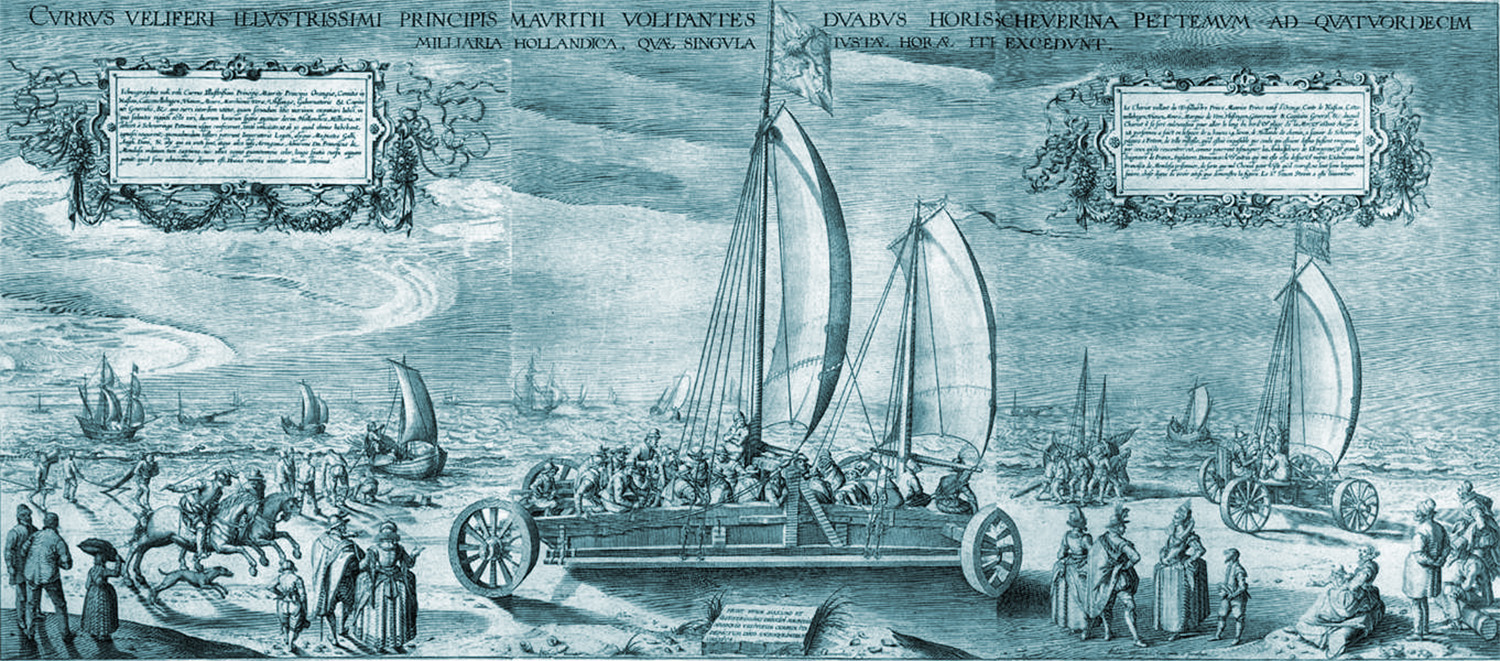
I’m honestly not sure what I think. Stevin’s wind-carriage is definitely a milestone of sorts, proof that wheeled travel on land was possible without the use of animal power. It wasn’t exactly practical, and it wasn’t really all that revolutionary – the same principles had been used on water for centuries – but it was still something, and is a milestone in the history of the automobile.
I think I’ve convinced myself that the arrangement of sails and related equipment counts as an “engine” of sorts – physical objects arranged in such a way to transfer some form of energy into motive force. An electric motor does this with streams of electrons, a gasoline engine does this with liquid hydrocarbons, steam engines do this with heat energy, and I suppose sails (and windmills, etc.) do this with the kinetic force of atmospheric motion that we call wind.
So maybe this can count as a sort of automobile? I’m happy to listen to any opinions here, because I think this is an interesting problem. Regardless, though, I do think this is likely the first non-fantastical, non-animal-powered, actually-existing wheeled vehicle mentioned in any literature. After all, Tristram Shandy was published about a decade before Cugnot’s 1769 steam artillery hauler was built!

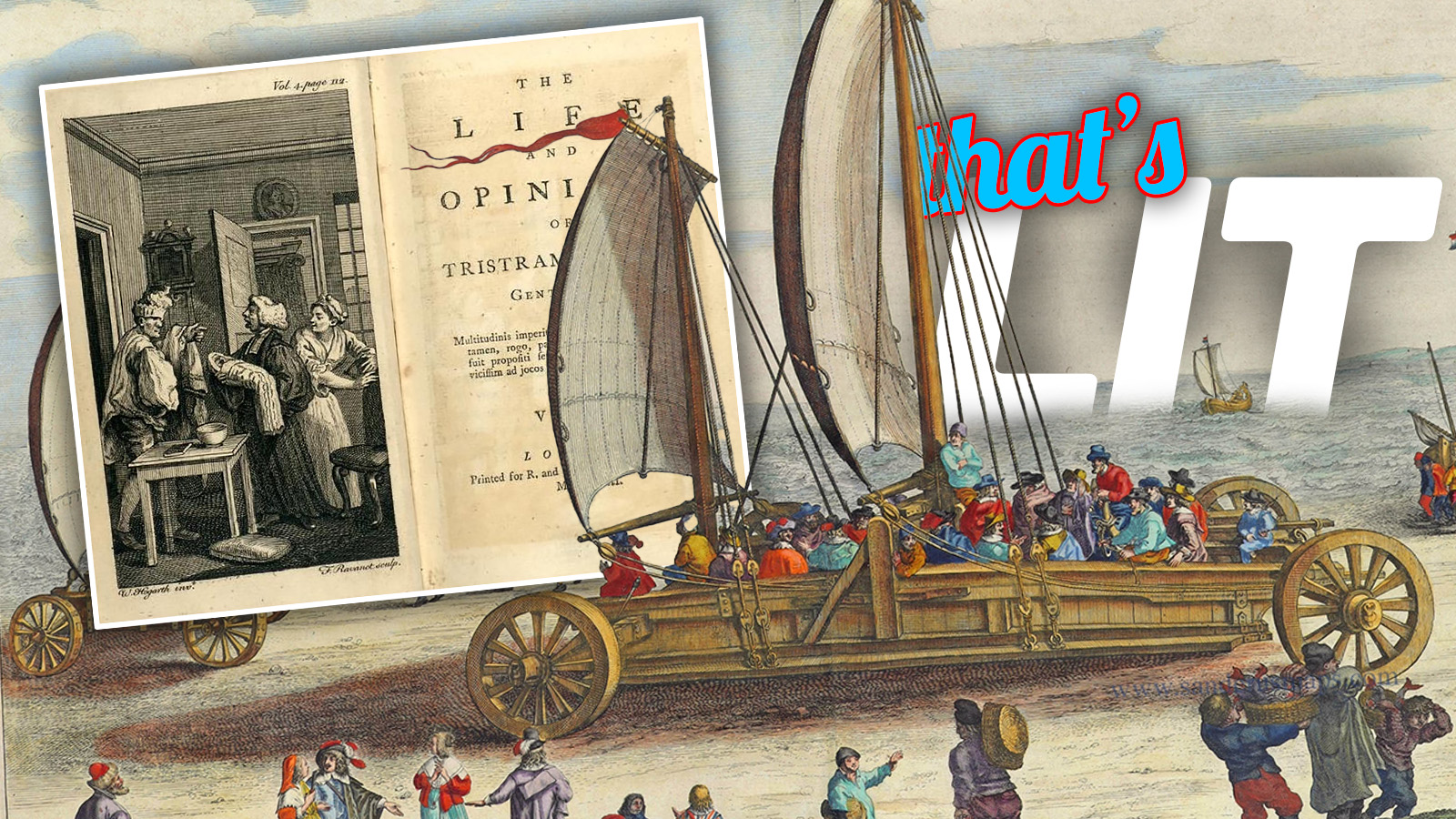



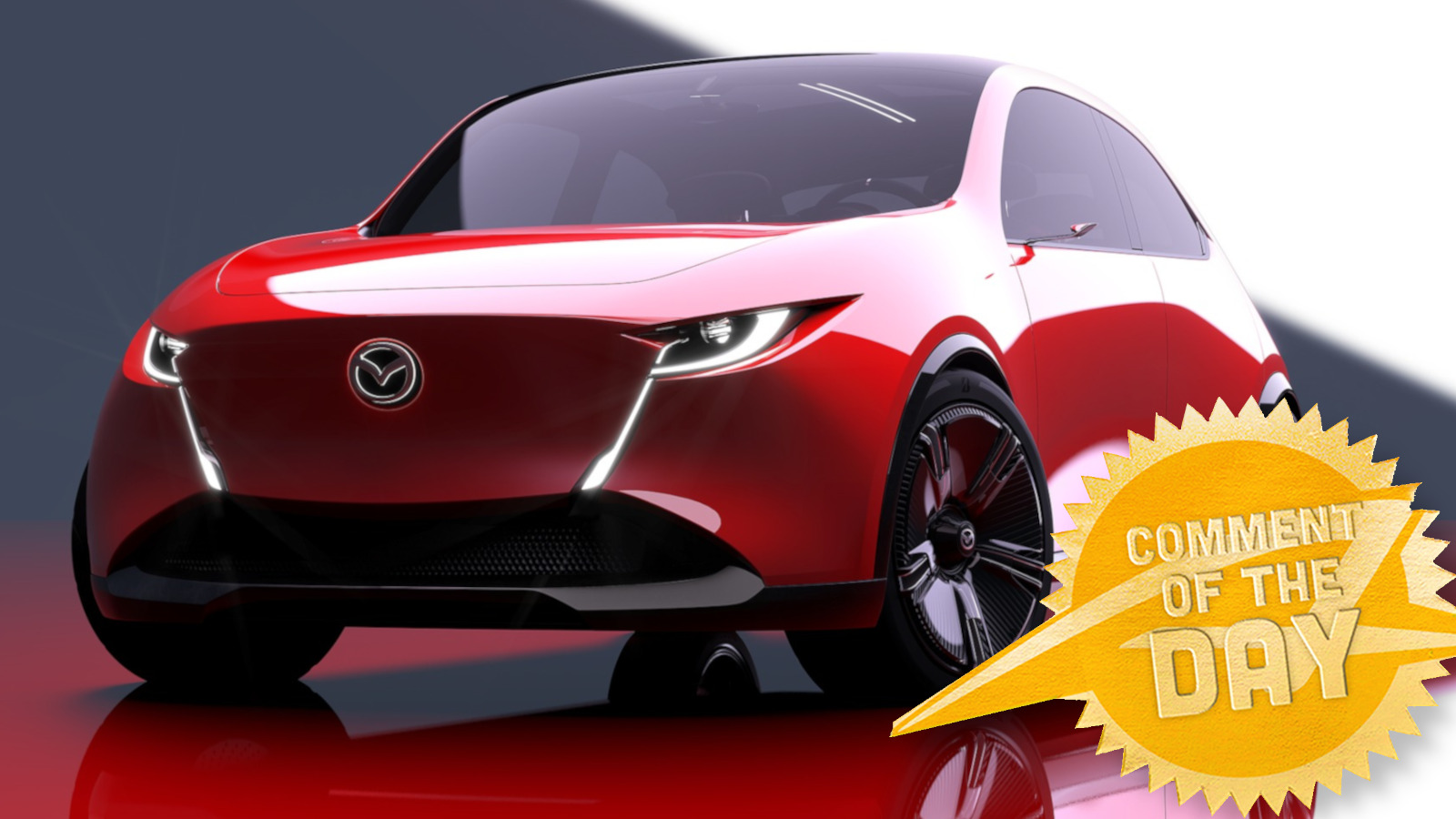

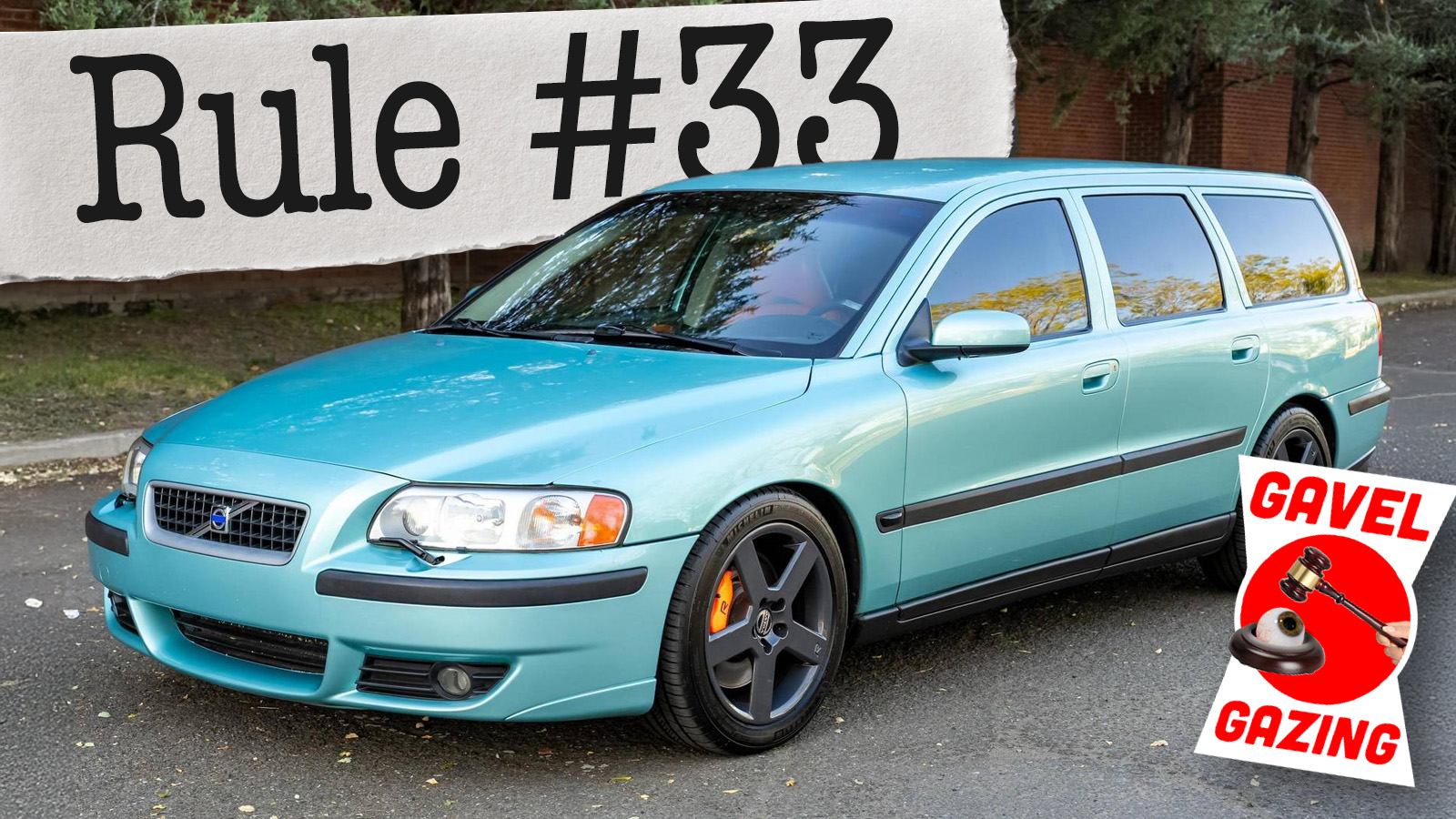
“who walked a matter of five hundred miles”
If I get drunk, well I know I’m gonna be
I’m gonna be the man who gets drunk next to you
And if I haver, hey I know I’m gonna be
I’m gonna be the man who’s havering to you
But I would walk 500 miles
And I would walk 500 more
Just to be the man who walks a thousand miles
To fall down at your door
Not one frikkin mention of tail lights. JASON DID NOT write this article. Damm you AI. Quit playing like you can out do the tail light king. They call it artificial intelligence, right? Intelligence can also have an IQ of about 12, apparently, just saying. not one word about a tail light.
Boring ass article, Jason, do better. My good deed for the day is done. This comment section is about to light up LOL!!!!!!!
PS, been following you and your fellow talented teammates for years now, since Jalopnik at least (AKA Jalopnik, political, Tesla haters only website now, bunch of shit inaccurate AI stories, too!) My family is in media. Will subscribe to Autopian til the day I die. I want ya’ll to always be here and succeed.. Please bring Murilee Martin to the Autopian family. He would add a lot of value and clicks to this site. His junkyard finds bring back so many happy memories. My mind still sees his finds on the showroom floor with the AMV dealer add on window sticker.(Talking 80’s import restriction days) Please recruit him for this site. Please, please, please, with sugar on top?
Seconded. That would be awesome
Your articles are just cray cray. That’s why I love you. I am disappointed you didn’t dig a bit deeper for this article. Are you being lazy here big JT? Surely, they had some kind of lamp they stuck on the back of that boat to serve as a tail light. Did that lamp have a partial amber Lense? I mean really, Jason, do better. Boring ass article. Trust me the comment section for this post is about to go nuclear blow up because of what I just said. Luv ya Jason. I looked up pao’s up for auction, you’re setting on a little gold mine
“The sails and mast and associated support and guide lines are not complex machinery….”
Really, Jason? Y’ever been sailing? I get your point, comparing a modern ICE with a sailing rig, but I’m just saying don’t sell a wind-powered vessel short. Like a vintage 4-cylinder engine you could disassemble and rebuild in a day, a straightforward Marconi-rig daysailer is relatively simple. But there also existed (and exist) behemoth mills under hoods compared with, say, a fully-rigged clipper ship.
Also, to weigh in on the question, IMO the answer lies in the word itself: “auto-mobile.” A sailing vessel is not an automobile because it does not move itself with the use of some form of stored, onboard energy. Whether that vessel sails the shore or the sea is irrelevant. $0.02.
I’m not sure it matters for Jason’s argument, but I want to note that sails don’t work the way landlubbers think they do. We tend to think of them as almost big bags for catching wind, but they’re actually much closer to wings, taking advantage of differential air pressure (this is why you can sail very nearly straight upwind, although 45º from windward is closer to optimal).
I bring it up simply to suggest that the translation of wind to motion in these land yachts was more sophisticated than one might think.
Yes! This is also why with the right kind of vehicle, you can sail at several times the speed the wind is blowing. Think of an iceboat or the wheeled equivalent, because the very low drag from the points of contact with the ground is key. As they gain speed, the relative wind an iceboat “sees” rotates farther and farther forward as well as speeds up. The efficiency of the airfoil goes way up, and these…vessels? vehicles?…vehicles can reach speeds of 50 knots or more in a brisk breeze.
Sorry, I can’t continue reading this — you can clearly see that it was written in 1761 and not 1759 because it is MDCCLXI and not MdCCLIX!
I hope you can’t sleep at night Torch, because I certainly won’t be.
“These events and milestones are interesting because at the time of their creation, it’s usually not especially clear what their eventual impact will be, and, maybe even more excitingly, often these firsts occur far earlier than one would guess.”
What I find most interesting about the gestation periods of many of the things we take for granted these days, is how little attention anyone at the time was paying to record keeping or documenting these events.
When I began the Koenigsegg Registry project, it was startling how little knowledge was kept of Koenigsegg’s early days, even within the company itself. In my efforts to document some of the early prototype cars, lots of times the answers I came to were, in effect, “Nobody knows, and nobody was really paying attention to that. We were just trying to build something.”
For a time, I became really interested by the early history of professional baseball. And not only did I discover that recordkeeping was very inconsistent during those days, no one really even knows when the first baseball game as we know it now was played. I find this fascinating.
What I’m saying is, if you’re working on something wacky that might not work, or if you and your buddies just invented a game in your garage, at least take note of what day it was.
INHO an automobile is a self propelled vehicle using a self contained power source not reliant on exterior forces so no. Why does it matter if the exterior force is animal, vegetable, or mineral or primal sources? I think auto has several definitions and like autocratic or automatic, can mean several things. After an automatic transmission is a self contained piece of equipment that does its job free of any external forces.
Yes, Automobile, and the first taxi.
Evidence being the poor guy hailing the taxi in the first pic getting passed by.
I had to stop reading after Tristram Shandy’s street takeover where he tried to use a rather powerful eddy to do donuts in the town square while Stevinus attempted to capture the whole thing with his pinhole camera. Uncle Toby is yet to be reimbursed for what happened to his prized goose.
I would say it is not an automobile for the simple reason that it does not release its own kinetic energy.
As you will no doubt recall, under normal circumstances, energy cannot be created or destroyed but only converted (shut up, Einstein, for a moment). And the thing an automobile does is convert some other form of energy into motion. That can be chemical energy, released by an ICE, or electrical, supplied by a battery, generator, solar panel or even stationary wire or induction track, but the kinetic energy is released on-board by an engine or motor.
So a cable car is not a “automobile” (besides that it has rails, but ignore that for a moment) because its kinetic energy is transferred to it by grabbing onto a moving cable. Same here: the kinetic energy is transferred to it by capturing wind, air that is already moving.
See my comments below – self contained power is the key. Be it battery, gasoline, coal, etc…
I beg to differ. I don’t think the self-contained bit is important; the provision of kinetic energy is. Otherwise, a trolley bus would not be an automobile, which I don’t think is a useful conclusion.
What about any object that rolls downhill? That’s converting stored gravitational potential energy into kinetic energy. If THAT counts the first “automobile” is likely much, much older than a few hundred years:
https://static1.srcdn.com/wordpress/wp-content/uploads/2024/07/far-side-october-23-1984-prehistoric-man-tied-to-a-wheel-about-to-be-pushed-down-a-hill.jpg
I was wondering that as well. Maybe it doesn’t count because it is not sustainable and can only go in one direction?
I’m not sure “sustainable” applies here as gravity is in this context a storage medium not an energy source. It’s a natural phenomenon which has existed since the universe began and it permeates the entire universe so on that level it’s quite sustainable.
Yes, “sustainable” is maybe not the right word. Gravity as a force in general is of course sustainable. But the gravitational energy stored in an object that is somewhat high up is only good for one trip, and maybe more importantly, the trip can only be in one direction: down.
Generally speaking “down” is the only option for any land vehicle parked at the top, regardless of its power source.
There is also the question of whether an automobile ceases to be an automobile when the tank is empty.
The first book I was assigned to read for my independent study in satire was Tristram Shandy. It is indeed a crazy book, particularly for its time, and worth the read. I think this might be the first time I’ve seen it referenced outside of scholarly literature publications. Nice work, Torch!
You can’t beat an autobiography that ends with the subject’s birth.
That’s why we come here
Consider the change in world Navys trasitioning from the age of sail to age of steam. I think self-contained power is the distinguishing factor.
Agreed. Run
onwhat you brung.“Ass, gas or grass…nobody rides for free”
I think the key determinant of what makes an automobile is that:
1) There needs to be a motor or engine that propels the vehicle AND
2) A use of stored energy to supply the motor/engine.
Wind is an external force; remove the wind and the vehicle cannot propel itself. Likewise, a soapbox derby car relies on gravity and cannot propel itself up a hill.
In my original definition I was tempted to say the use of a motor/engine as the primary determinant, but a solar powered car with no battery storage is just as much at the mercy of the sun as the sail powered cart is at the mercy of the wind. However, add a battery to store the energy provided by the sun and a solar powered car can run at night – hence, an automobile. A combustion-powered car, whether it be powered by steam, turbine, internal combustion engine, fuel cell, or something else relies on the energy stored in whatever fuel it burns.
LATE EDIT: Someone brought up DaVinci’s “wind-up” car. That would absolutely be an automobile as the potential energy would be stored in something like a spring and then could be used at the desired time for self-propulsion.
I think self contained power is the determinant. Solar car – No. Solar car with battery – Yes. Naval power was transformed by the steam engine – now overall maneuverability was fully in control of the Captain. No waiting for favorable winds, he controlled his own destiny.
You use a naval example. Must a car run on land? If not, a galley ran on stored power (the poor sods who pulled the oars). A parachute runs on the stored energy of gravity, though that’s a one-way trip. A bicycle runs on the stored energy of the rider. If 4 wheels are required, roller skates do also.
No, a bicycle does not. The rider converts chemical to energy by pedalling; the bicycle only converts it to forward motion. The rider is not part of the bicycle.
A parachute largely relies on the person (or cargo) to provide downward motion. Without it, the trip would be much longer. A galley does not provide its own kinetic energy, the poor sods (who are not part of the galley) do. Same, of course, with a rowing boat.
Guess it depends on definitions. I’d say the bicycle rider is the motor/stored energy, likewise the galley oarsmen. (The parachute relies on gravity to convert potential to kinetic energy, but that’s maybe similar to a sailboat and wind.) Does the motor or container of stored energy need to be an irremovable part for a car? Would a car with a removable motor still be a car? An automous car, where the rider is not the operator? Lawyers and philosophers will argue over this for centuries, until there are no cars.
This concept of on-board motive power has me picturing an automobile where a horse runs on an onboard hamster wheel to raise a trebuchet-style weight to store motive energy.
Hopefully giant-counterweight technology will improve to the point that the automobile can go a reasonable range before having to fill up at the next horse-drawn-gravitational-potential-energy filling station.
There’s an old joke about GM building a spring-powered car taking the idea from the toy industry. It could go from New York to LA on a single windup, but the hard part was pushing it backwards from Detroit first.
“Likewise, a soapbox derby car relies on gravity and cannot propel itself up a hill.”
Sure it can if the hill it’s about to climb is lower than the one it just came down.
Gravity is a battery too and its how we store 95% of all grid energy:
https://en.m.wikipedia.org/wiki/Pumped-storage_hydroelectricity
I feel like for it to count as an automobile, you have to be able to store the fuel on-board. I don’t think there’s a conceptual difference between pouring gasoline into a vehicle, or charging a battery with outside electricity or an on-board solar panel. I think sail cars are cool but not automobiles. If there’s no wind it won’t go and you can’t save up air when it’s available to go when there’s no wind.
You’re making me repeat this fact from 1478
https://en.wikipedia.org/wiki/Leonardo's_self-propelled_cart
But I don’t think that was ever made/used.
Yeah that’s the way that link states it, but a documentary on Leonardo stated that he had an assistant ride on top of a “magic carpet” to amuse a king.
Is a sail boat not a boat? Any vehicle of any kind is ultimately solar powered. This just has a different way of harnessing that energy.
So that’s a great analogy.. What about a wind up car like Di Vinci’s (never made)? all “cars” as described by non-pendants, would be a vehicle that is converting potential energy into kinetic. How the potential is created shouldn’t matter, batteries, gasoline, bacterial fluctuance… I think the question is are sunlight and wind already kinetic? Because even if you argue a solar car only changes kinetic to kinetic, it’s still 100% a car, so is the wind chariot.
Sunlight would be electromagnetic energy.
Sure but what state is it in?
He would walk five hundred miles
And he would walk five hundred more
Just to be the man who saw the chariot
Flying along on wheels of four
Da-da da da (Da-da da da)
Take your COTD win with this one.
Will the real ‘Stram Shandy please stand up?